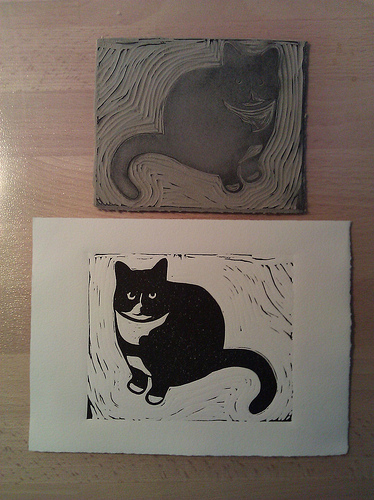Debugging my Creative Process
I’ve been taking print making classes this year, and have really enjoyed exploring something new. What’s been particularly interesting for me is seeing parallels between what I think of as a creative hobby – print making – and what I think of as creative work – writing software.
I showed my work publicly for the first time two weeks ago. The day after the show I had booked time in the studio. I showed up after work that day with my tools, anxious to get back to printing. It had been a couple weeks since I’d been in the studio, and last time I was there had been very productive: I’d spent the entire day working with the same image, producing six unique prints as I tried to add more texture and depth to the precise lines of the stencils I’d been creating. The result was a set of prints which were somewhat uneven in quality, but which showed a progression of control and vision. With each one I tried something a little different, until I felt like I had a good understanding of what I really wanted. Going into the studio that evening, I had about three hours of printing time, and hoped to bring that same exploration to another image.
I did wind up with five prints that evening, but none of them resonated for me like the Golden Gate Bridge prints did. As I pulled each print, I’d look at it, realize it wasn’t what I’d had in mind, and try to think about what to do next. Time in the studio usually passes quickly, and I feel like I’m racing the clock to do everthing that comes to mind. But that evening felt disjointed and choppy, and when it came time to clean up, I was ready to go home. I’d tried serious, whimsical, and abstract, and none of them felt like they worked for me that night. As I rode home from the studio, I felt disappointment. The experience wasn’t the effortless expression of creativity I was used to, and the work I had produced didn’t speak to me as I hoped and had come to expect.
The next morning I looked over the pieces again, and I realized that in each case there was one or two things that I didn’t like, which overwhelmed the rest of the piece. In one case I made a choice about negative space that turned out to be the wrong one. In another I tried to do too much at once, and my vision hadn’t translated well onto paper. As I stood there looking at each piece, I thought to myself, “Why didn’t you just do this exact same image again, but change the aspect you didn’t like?” Somehow I’d forgotten that it was OK to repeat yourself, to try again if the result wasn’t what I was looking for. I’d fallen into the trap that creativity is all about the flash, the spark, and that it just magically happens.
If I think about writing software, I’m well aware that getting the result I want is real work: we have test suites, debuggers, and continuous integration tools for a reason. We often don’t get it right on the first try. Just because the “test suite” for print making is personal and subjective doesn’t make iteration any less important.
I had my first linocut class Wednesday evening. Linocut involves carving a linoleum plate with an image, which you can then use to make a print. Our instructor asked us to bring a simple image to use for our first plate, and to get some experience with carving. I spent some time searching for the “perfect” image to use, something that I would be new and different and push the boundaries of my print making. In the end I wound up taking one of my monotype stencils and generated a scaled down version of it. And I couldn’t be happier with how it turned out.

Yes, it’s the same cat that I’ve been working with for the past couple months. But that doesn’t mean I’m not expanding my skill set, trying different techniques, and iterating. I have plenty of time to try new images out, and if I spend the time now, debugging my technique and learning how to iterate (just like I do with software), I think my ability to tackle more complex and involved work will grow, just like it has with software.